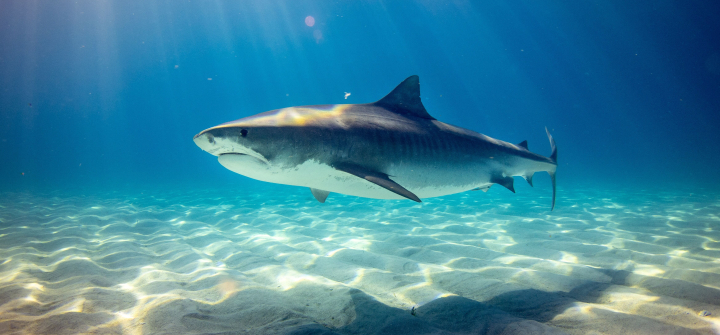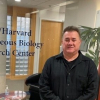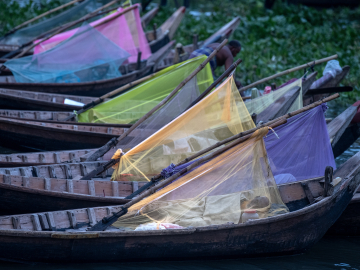I Walked a Shark and Found My Way Into Science
Growing up, we lived a block and half from the ocean. So going fishing was a summer thing my friends and I did almost every week. It was free, it was fun, and we could do it together—we also brought home dinner, which was a good thing, too.
There were eight or nine of us friends all together, all boys, all growing up in our working-class neighborhood where we didn’t have a lot. So for fishing trips, I’d be the one behind the scenes making sure we had everything ready, everything we needed. Sure you could go to the bait shop and get bait, but if there was something we could do without spending any money we did it. So, the day before fishing we’d go down to the beach, dig some sea worms, get some clams, we’d make a day of it: go to the beach, go swim, wait for low tide, and then get bait. We would go as a group. We chose a bridge we always fished from because it was within biking distance– 3 to 4 miles away from our small section of Revere. A few kids had the new birthday bike, but most of us had hand-me-downs or used bikes that were way past new. So before the trip we’d say who was coming, we’d check whose bike had a problem, and then that afternoon make sure we fix the flat or figure out what was wrong with the chain and grease it or plan for someone to ride double if we needed to. And even with all the planning, sometimes a bike would break down halfway there and we’d stop and use our pocketknives and tool sets and fix it. There were also lots of garages on the route who were open to helping us out, and air for the tires was always free.
We’d get to the bridge and fish. There was a little seafood place right next door. None of us was getting the lobster roll or the clam plate or anything expensive, but if we combined our money, we could buy French fries or a soda to share. This fishing bridge was near the airport, so we could watch the planes flying in as we looked out over the salt marsh waiting for our turn to take a sip or a bite. Anything else we did besides fishing trips was handled the same way—pickup games of ball or days at the beach. Kids in those days made their own fun and planned it as well, with an understanding it would be much more fun if all of us were able to participate.
In high school, I ended up volunteering for the New England Aquarium. I got to do the hands-on stuff behind the scenes—the nuts-and-bolts stuff, less glamorous stuff, like taking water samples or scrubbing the rocks in the cold marine gallery where the giant lobster and the Pacific octopus lived. And that way the gallery manager could go on to bigger and better things, like planning exhibits for visitors. At one point we found a crack in one of the glass viewing panels at the bottom of the Aquarium’s central tank. To put this in perspective, we’re talking about a round multi-level tank, almost as tall as the building’s interior, that contained over 180,000 gallons of seawater. Repairing this glass meant that the fish in the aquarium had to be removed and housed in other tanks until they could be returned to their home. They knew I was a hard worker. So, when this happened, it was really something nice that they came to me and said I could have a spot in this final reaction team.
Over the next few days, the small fish were trapped and relocated. The penguins were moved from their usual gallery into a back holding room to make room for the big animals. All that was left was the sharks. The pro scuba divers went into the main tank and got these nets attached to a hoop around each shark, forcing them to swim while dragging the weight of the net, to tire them out. Then, they would lower them down on stretchers to me and another diver, standing chest-deep in the penguin exhibit water. My job was to walk the tired sharks through the water and keep oxygen moving through their gills, so they didn’t suffocate. The fish swam around us, and every once in a while, a sea turtle would go by. In the dim light and the humid smell of wet concrete, it was like I was part of the exhibit. I kept walking laps in the tank until the shark seemed to perk up and then I let it swim off on its own, and then I’d let them know I was ready for the next one. Wading around that tank, I saw that a seemingly straightforward problem like replacing some cracked glass could require a big, coordinated solution. I saw us work as a team and felt everyone on that team had value and a purpose.
My love of the ocean and the aquarium led me to earn a degree in Marine Biology. But in this field, I couldn’t afford the picket fence, let alone the house behind it, so I went from beach work to bench work and then to a stable salary of administrative work. Now I oversee the facilities operations of 14 dermatology research labs at Mass General Hospital.
One of our PI’s got this grant to buy a confocal microscope, one with a tunable white laser that would allow him to image the cells in greater depth. Usually we try to avoid everyone purchasing their own microscopes and instead pool resources and use a communal one, otherwise 14 of them would sit around like paperweights. But this was for his specific research, and he said he needed this one. He said, “Look, I need to buy this scope, and it’d be great if I could have it near my tissue culture room, where the cells are grown.” We looked at lots of rooms, and we found one next to the tissue culture space that had most of what we needed - dimmable lighting, data ports in the wall, the right electrical outlet requirements. But what was not there was a cooling system. This microscope has no tolerance for even the slightest temperature increase or there’d be a drift in the imaging. The PI didn’t want to worry himself about how to get this room to hold temperature, that was my job. And it took a team - the engineer planned it, the construction company built it along with the HVAC person who put in the duct work so the air would diffuse and not blow dust on the scope, the buildings and grounds guys programmed the system to maintain temperature, and even the painter came in to make sure it looked nice before the PI moved in.
It’s important that we see not just the science in our hospitals, labs, and universities, but also see the stuff behind the scenes that goes into making things work–making science work. You don’t have to know Luke, the foreman of the building and grounds department, or Manny, the guy who does the waxing on the floors, or my glassworks person, Mark. But you should know that when Luke makes sure the lab has lights and heat and plumbing, when Manny makes sure the floor in the tissue culture room stays free of contaminants, and Mark walks through the lab and picks up your glassware, they’re part of the success of our day-to-day work. They’re part of our team. And everyone on that team has value. And a purpose. My wish is that all of us remember that.
John Dello Russo is director of Research Facilities Management for the Cutaneous Biology Research Center at Massachusetts General Hospital.
Read more “Living Science” stories here.
Join the 50,000+ subscribers in 170+ countries who rely on Global Health NOW summaries and exclusive articles for the latest public health news. Sign up for our free weekday newsletter, and please share the link with friends and colleagues.





